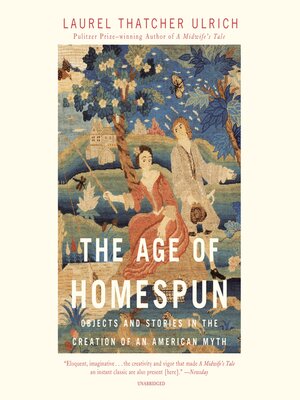The Age of Homespun
audiobook (Unabridged) ∣ Objects and Stories in the Creation of an American Myth
By Laurel Thatcher Ulrich

Sign up to save your library
With an OverDrive account, you can save your favorite libraries for at-a-glance information about availability. Find out more about OverDrive accounts.
Find this title in Libby, the library reading app by OverDrive.



Search for a digital library with this title
Title found at these libraries:
| Loading... |
Using objects that Americans have saved through the centuries and stories they have passed along, as well as histories teased from documents, Laurel Thatcher Ulrich chronicles the production of cloth—and of history—in early America. Under the singular and brilliant lens that Ulrich brings to this study, ordinary household goods—Indian baskets, spinning wheels, a chimneypiece, a cupboard, a niddy-noddy, bed coverings, silk embroidery, a pocketbook, a linen tablecloth, a coverlet and a rose blanket, and an unfinished stocking—provide the key to a transformed understanding of cultural encounter, frontier war, Revolutionary politics, international commerce, and early industrialization in America. We discover how ideas about cloth and clothing affected relations between English settlers and their Algonkian neighbors. We see how an English production system based on a clear division of labor—men doing the weaving and women the spinning—broke down in the colonial setting, becoming first marginalized, then feminized, then politicized, and how the new system both prepared the way for and was sustained by machine-powered spinning.
Pulling these divergent threads together into a rich and revealing tapestry of the age of homespun, Ulrich demonstrates how ordinary objects reveal larger economic and social structures, and, in particular, how early Americans and their descendants made, used, sold, and saved textiles in order to assert identities, shape relationships, and create history.






